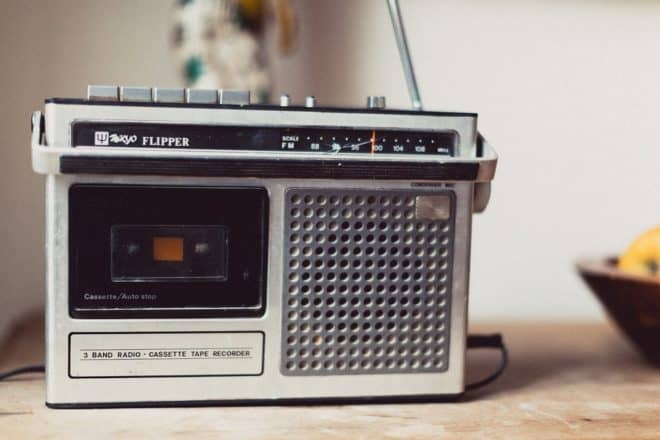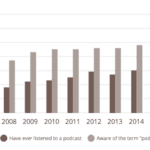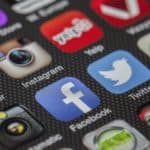What Podcasts Can Learn From the Radio

Podcasts are often heralded as the next big medium and it’s easy to see why. In 2017, Nielsen found that 60 million Americans are podcast fans. This year, podcast are expected to become a $500 million industry. But there’s an elephant in the room regarding the rapid expansion of this “revolutionary” medium. It’s not really new.
In the form of radio, audio only entertainment has been a part of popular culture for over a century. You may think that podcasts have replaced this seemingly archaic technology – but they haven’t. According to a different Nielsen poll last year, 81% of Americans still listen to the radio while driving – compared to the 26% that listen to podcasts.
One possible explanation for this drive-time discrepancy could just be convenience. Your car automatically plays your favorite radio station the moment you turn the ignition. Podcasts, on the other hand, are an intentional medium. You can never accidentally listen to a podcast, and that goes double when your driving, where you often have to retrofit your vehicle with Bluetooth before you can connect Spotify to your speakers.
And once you’re actually listening to your podcasts or radio show, you’ll likely be listening to similar types of programming. The three most popular genres of podcasts have their roots in radio – comedy, education, and news. On both mediums you can easily find roundtable political discussions or fictionalized dramas. The content is so platform agnostic that many podcasts are cross pollinated on the radio and vice versa.
All of this begs the question, how are podcasts really all that different from radio? In my mind, this is the defining question that the podcast industry should meditate on. Podcasts feel new, but as the industry continues to bloom – both financially and creatively – we shouldn’t forget our forefathers.
In the early 1900’s radio technology was seen as a fad. But by 1917 there was 13,581 radio operators – all of whom where amateurs. Just like podcasting, the artform grew from hobbyists. As this hobby continued to grow in popularity, many operators actively competed for airspace. Two broadcasts on the same frequency would bleed together into a cacophonous mess. By 1926, the radio space became so chaotic the government decided to step in by creating the Federal Radio Commission. A year later, the nascent commission legally took control over the whole industry, issuing a limited amount of licenses to the American public.
Technological limitations forced radio to become less democratic, but that’s one issue that podcasts don’t have. The bandwidth of the internet is essentially infinite. While the podcast space is definitely crowded, you’ll never hear Marc Maron bleed into your regularly scheduled Pod Save America.
As the radio industry became more formalized, it also became more commercialized. In 1938, 40% of the countries radio stations were affiliated with a network. Although we don’t have the exact data, it’s easy to see how podcast networks – instead of independent productions – are becoming similarly dominant. Once networks focussed their efforts on radio, they dominated the entire entertainment industry. According to the Economic History Services, in the 1930’s, radio “was so popular that theaters dared not open until after the extremely popular ‘Amos ‘n Andy’ show was over.”
But I don’t suspect a similarly historic rise in podcasting, and here’s why: television. Radio was the dominant form of entertainment because it was the best they had. In the 1940’s and 50’s, millions of Americans quietly turned off their radios and agreed that TV was better. 70 years later, TV is still the default form of entertainment. While podcasts are more popular than they’ve ever been, there’s no way that the medium can reclaim the throne that radio once held.
Radio and then television largely served the function of a do-nothing activity. In the idealized American home, you get home from a hard days work, drink a beer and listen to or watch the baseball game. This is not how we interact with podcasts.
While 49% of podcast listening occurs at home, this is usually in conjunction with another activity. Because of our smartphones, we are constantly multi-tasking. We have been groomed to expect constant entertainment. 45% of Americans admitted to “always or very often” using their smartphones while watching TV. Now with the proliferation of smart speakers, we can use podcasts to continue our constant entertainment.
At their core podcasts are radio for modern age, but they will never be the default entertainment that radio once was. While technology has obviously improved since radio – its form is largely the same. Podcasts aren’t revolutionary in their form, but their function.
Ultimately, while there is much to be celebrated about the art of podcasting, I think that its content is given too much credit for its popularity.
When it comes to modern media consumption, convenience is always king. Spotify purchasing Gimlet and Anchor isn’t monumental because of its content. It’s monumental because Spotify is slowly consolidating your listening habits to their platform. Whether it be music or podcasts Spotify hopes to have be your hub for listening – conveniently.













1 comment
Taylor, interesting thoughts, but radio and podcasts can each do things the other can’t, in both delivery and content. Radio stations reach all listeners in real time, but are limited to coverage of a specific geographic area, and typically need to attract a minimum of 2 – 5% of that market’s listening to survive. That pushes radio programmers toward content of wide general interest (or lowest common denominator). Podcasts can thrive on .000001% of the whole world’s listening, which allows deeply niched and longer shows which would be unsuccessful on radio. And that’s the source of the intimacy and listener-host connections which have advertisers fascinated with podcasting.
Comments are closed.